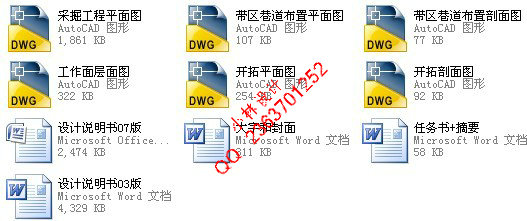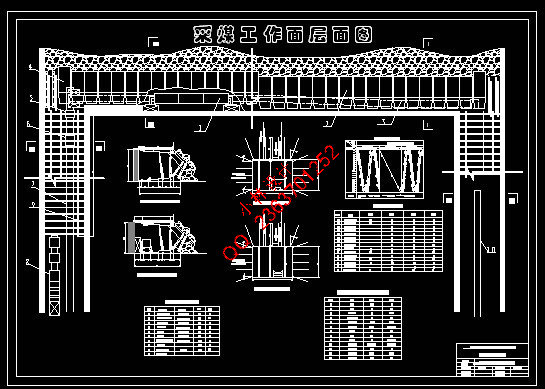|
设计简介 |
设计描述:
文档包括:
word说明书一份,共133页,约68000字
CAD版本图纸,共5张
摘 要
本设计包括三个部分:一般部分、专题部分和翻译部分。
一般部分为曲江煤矿1.2Mt/a新矿井设计。曲江煤矿位于江西省丰城市曲江镇境内,地理位置优越,交通便利。本井田基本呈一单斜构造,构造复杂程度简单。地层比较平缓,煤层倾角为7°。井田内B4煤层全区稳定可采,为主要可采煤层,最大厚度4.2m,平均厚度3.5m。
矿井工业储量为138.74814 Mt,可采储量96.77069Mt。矿井服务年限为62年,正常涌水量为30m3/h。矿井瓦斯涌出量12 m3/t,属于高瓦斯矿井。煤尘不具有爆炸危险性,煤的自燃倾向等级为Ⅱ级自燃,发火期为3~6个月。
立井开拓不受煤层倾角、厚度、深度、瓦斯及水文等自然条件的限制。斜井的运输能力比立井大,可满足大型矿井的需要;但辅助提升比较困难,通风也不利(特别是开采深部煤层,斜井分段提升辅助环节多,能力小;而且通风线路长、阻力大、风量小,不能满足生产要求)。本井田瓦斯大,埋藏深,宜用立井开拓。
矿井采用立井单水平带区开拓,一水平标高为-800 m。采煤方法主要为走向长壁综合机械化一次采全高。采用一矿一面的高效作业方式,工作面长度为200m。运输大巷采用胶带运输煤炭,轨道大巷采用蓄电池电机车牵引1.5t固定式矿车运输矸石和材料等。
为了节省初期井巷工程量,减少投资,尽快投产,初期形成中央并列式通风系统。到生产后期,随着通风线路加长,中央并列式通风系统难以满足通风要求,固后期采用两翼对角式通风系统。设计采用抽出式通风方式。
矿井年工作日为330d,工作制度为“三八”制。
一般部分共包括10章:1.矿区概述及井田地质特征;2.井田境界和储量;3.矿井工作制度、设计生产能力及服务年限;4.井田开拓;5.准备方式—带区巷道布置;6.采煤方法;7.井下运输;8.矿井提升;9.矿井通风与安全技术;10.矿井基本技术经济指标。
专题部分题目是浅析曲江矿瓦斯抽采技术与应用。
主要分析曲江矿在瓦斯抽采技术方面的成熟运用以及所取得的成就,对国内外其它矿井具有借鉴意义。
翻译部分为3000字左右的英译汉文章。
题目:锚杆支护系统在煤矿巷道中的应用与改进
关键词:锚杆支护 锚索 联合支护 安全保障
ABSTRACT
The design consists of three parts: general part, special part and the translation part.
General part Qujiang mine 1.2Mt / a new mine design. Abundance of coal in the city of Jiangxi Province Qujiang Qujiang town, geographical location and convenient transportation. Mine was one of the basic monoclinic structure, structural complexity simple. Relatively gentle formation, coal bed inclination of 7 °. Ida stability in the region B4 recoverable coal, for the main coal layer, the maximum thickness of 4.2m, the average thickness of 3.5m.
Mine industrial reserves 138.74814 Mt, recoverable reserves 96.77069Mt. Mine service life of 62 years, the normal discharge is 30m3 / h. Mine Gas Emission 12 m3 / t, is high gas. Does not have the explosion of coal dust hazard, level of spontaneous combustion of coal grade Ⅱ spontaneous combustion, combustion period of 3 to 6 months.
Open from coal shaft angle, thickness, depth, natural gas and hydro conditions. Inclined shaft of transport capacity than large, which can meet the needs of large-scale mines; but more difficult to increase aid, ventilation is also negative (deep coal mining in particular, enhance the secondary links and more inclined segment, capacity is small; and ventilation lines long, the resistance large air volume is small, can not meet production requirements).
The large gas Ida, buried deep, to use the vertical shaft development.
Mine shaft used to develop single-level band, a level of elevation of -800 m. Mining methods for the mechanized longwall mining overall high. Efficient use of a mine face practices, with working length of 200m. Transportation Roadway with tape transport of coal, rail roadway with battery motor vehicle towing 1.5t stationary tramcar transport waste rock and materials.
To save the initial roadway quantities, reduced investment, production as soon as possible, parallel the early formation of the central ventilation system. To the production of late, with the ventilation line extension, the central parallel air ventilation system can not meet the requirements of the two wings of the corner with solid post-ventilation system. Design uses exhaust ventilation mode.
In working for the mine 330d, working system for the "March" system.
General part of the total, including 10 chapters: 1. Mine and Minefield overview of features; 2. Ida realm and reserves; 3. Mine work systems, design and production capacity and service life; 4. Well field development; 5. Preparations of - band roadway layout ; 6. mining methods; 7. underground transport; 8. Mine; 9. mine ventilation and safety technology; 10. mine the basic technical and economic indicators.
Part of the title topic of Qujiang Mine Gas Drainage Technology and Applications.
Analyzes the Qujiang mine gas extraction technology in the advanced skills and achievements, to be learned by other domestic and foreign mine.
3000 words translated some articles about Yingyi Han.
Title: Bolt system in coal mine roadway and improvement of
Key words: bolting and cable supporting security
目 录
一般设计部分
1 矿区概述及井田地质特征 3
1.1 矿区概述 3
1.1.1 地理位置 3
1.1.2 地形特点 3
1.1.3 交通条件 3
1.1.4 工农业生产、原料及电力供应 3
1.1.5 气候条件 3
1.1.6 水文情况 3
1.1.7 地震情况 3
1.2 井田地质特征 3
1.2.1 勘探程度 3
1.2.2 井田煤系地层概述 3
1.2.3 地质综合柱状 3
1.2.4 地质构造 7
1.2.5 水文地质特征 9
1.3 煤层特征 3
1.3.1 煤层埋藏条件 3
1.3.2 煤层群特征 3
1.3.3 煤层的围岩性质 3
1.3.4 煤的特征 3
1.3.5 煤层瓦斯含量 3
1.3.6 煤的自燃与爆炸 3
2 井田境界和储量 3
2.1 井田境界 3
2.1.1 井田范围 3
2.1.2 开采界限 3
2.1.3 井田尺寸 3
2.2 矿井工业储量 3
2.2.1 储量计算基础 3
2.2.2 钻孔及勘探线分布情况 19
2.2.3 矿井工业储量的计算及储量等级的圈定 19
2.3 矿井可采储量 20
2.3.1 井田安全煤柱 3
2.3.2 矿井可采储量 3
3 矿井工作制度、设计生产能力及服务年限 3
3.1 矿井工作制度 3
3.2 矿井设计生产能力及服务年限 3
3.2.1 矿井设计生产能力 3
3.2.2 矿井服务年限 3
3.2.3 井型校核 3
4 井田开拓 3
4.1 井田开拓的基本问题 3
4.1.1 确定井筒形式、数目、位置及坐标 3
4.1.2 工业场地的位置、形状和面积 3
4.1.4 开采水平的确定及带区划分 3
4.1.5 主要开拓巷道 3
4.2 方案比较 3
4.2.1 方案说明 3
4.2.2 开拓方案技术比较 3
4.2.3 方案一、三的经济比较 3
4.3 矿井的基本巷道 3
4.3.1 井筒 3
4.3.2 井底车场 3
4.3.3 主要开拓巷道 3
5 准备方式——带区巷道布置 3
5.1煤层地质特征 3
5.1.1 带区位置 3
5.1.2 带区煤层特征 3
5.1.3 煤层顶底板特征 3
5.1.4 水文地质 3
5.1.5 地质构造 3
5.1.6 地表情况 3
5.2 带区巷道布置及生产系统 3
5.2.1 带区准备方式的确定 3
5.2.2 带区巷道布置 3
5.2.3 带区生产系统 3
5.2.4 带区内巷道掘进方法 3
5.2.5 带区生产能力及采出率 49
5.3 带区车场选型设计 3
5.3.1 带区车场的形式和线路布置 3
5.3.2 带区主要硐室布置 3
6 采煤方法 3
6.1 采煤工艺方式 3
6.1.1 采煤方法的选择 3
6.1.2 回采工作面长度 3
6.1.3 工作面推进长度和推进方向 3
6.1.4 采煤工艺 3
6.1.5 落煤方法 3
6.1.6 采煤机进刀方式 3
6.1.7 采煤机破煤、装煤方式 3
6.1.8 移架方式 59
6.1.9 采煤工作面支护方式 3
6.2 工作面顶板管理 3
6.3 工作面上、下端头及出口的顶板管理 3
6.4 采煤工作面正规循环作业 3
6.5 回采巷道布置 3
6.5.1 回采巷道布置方式 3
6.5.2 回采巷道支护 3
7 井下运输 3
7.1 概述 3
7.1.1 矿井设计生产能力及工作制度 3
7.1.2 煤层及煤质 3
7.1.3 运输距离和货载量 3
7.1.4 矿井运输系统 3
7.2 带区运输设备选型 3
7.2.1 设备选型原则 3
7.2.2 带区运输设备选型及能力验算 3
7.2.3 带区绞车的运输能力验算 3
7.3 大巷运输设备选型 3
7.3.1 轨道大巷设备 3
7.3.2 胶带大巷设备 3
8 矿井提升 3
8.1 概述 3
8.2 主副井提升 3
8.2.1 主井提升设备选型 3
8.2.2 副井设备选型 79
9 矿井通风及安全 3
9.1 矿井通风系统选择 3
9.1.1 矿井通风系统的基本要求 3
9.1.2 矿井通风方案的技术比较 3
9.1.3 通风方式的确定 3
9.1.4 采煤工作面通风 3
9.1.5 矿井通风容易和困难时期通风立体示意图及通风网路图 3
9.2 矿井风量计算 3
9.2.1 采煤工作面所需风量的计算 3
9.2.2 掘进工作面需风量 3
9.2.3 硐室需风量 89
9.2.4 其它巷道所需风量 89
9.2.5 矿井总风量 89
9.2.6 风量分配 3
9.2.7 风速验算 3
9.3 矿井通风阻力 3
9.4 矿井主要通风机选型 3
9.4.1 矿井自然风压 3
9.4.2 主要风机选型 3
9.5 防止特殊灾害的安全措施 3
9.5.1 预防瓦斯和煤尘爆炸的措施 3
9.5.2 预防井下火灾的措施 3
9.5.3 防水措施 3
10 设计矿井基本技术经济指标 3
专题设计部分
浅析曲江矿瓦斯抽采技术与应用 3_Toc295161172
翻译部分
英文原文 3
中文原文 3
参考文献 127
致 谢 3
|









